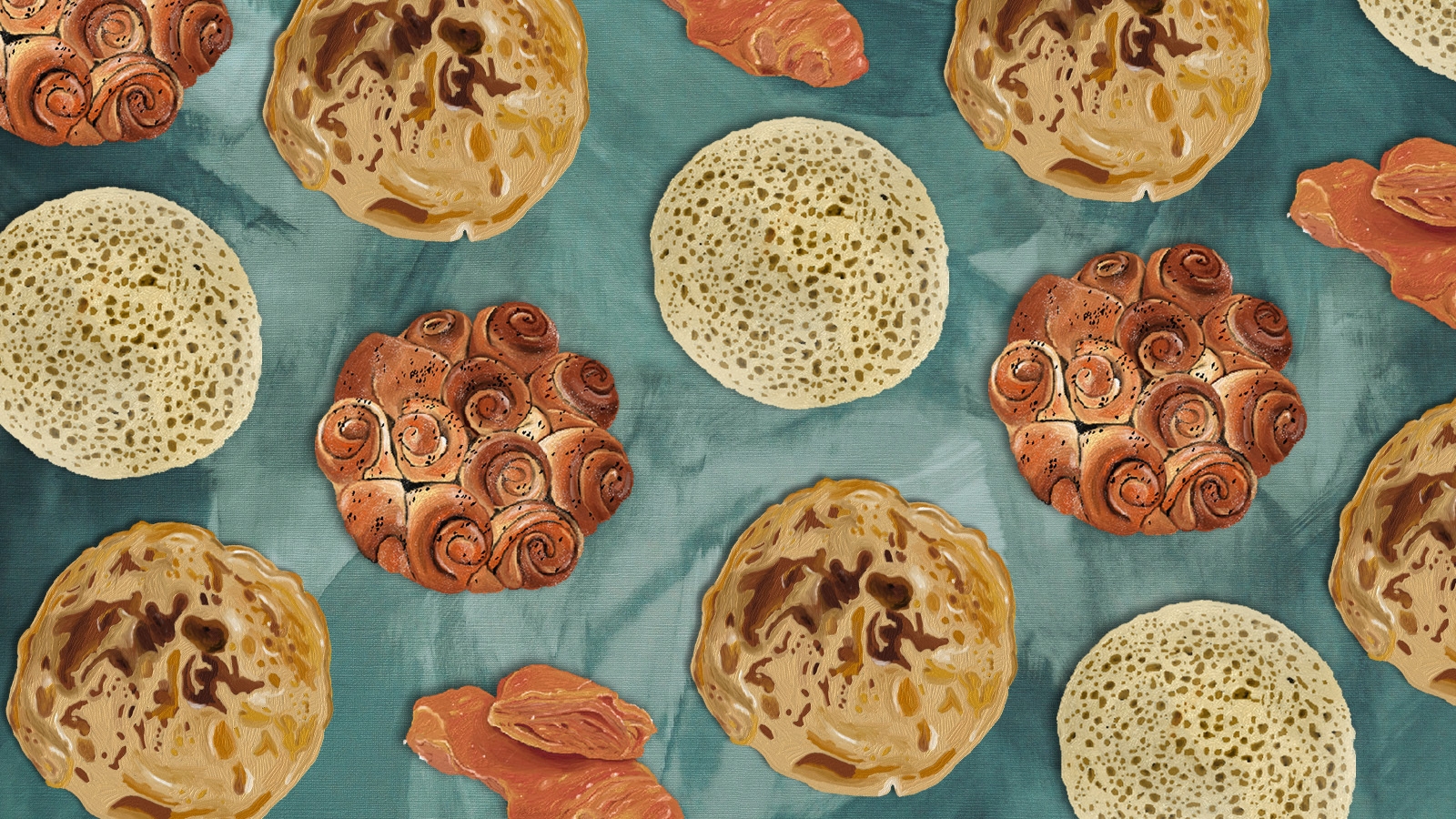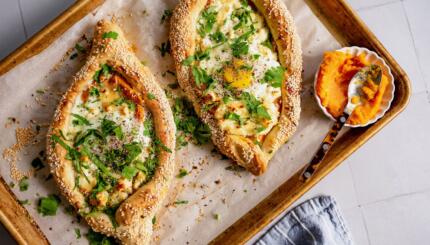Yemenite Jews know how to bake. Their bread tradition (which, here, also includes savory pastries and pancakes) is varied and unique — from rich, buttery breads cooked in the oven overnight to fluffy flatbreads fried up quickly in a skillet.
Forty-nine thousand Yemenite Jews facing persecution were airlifted to Israel between 1949-1950, many settling in Tel Aviv. Their bakery tradition has been woven into Israeli cuisine, where it is both honored and elevated. Outside Israel, Yemenite Jewish breads are woefully underappreciated, though that is starting to change thanks to Israeli chefs like Meir Adoni and Einat Admony, who introduced some of them to the U.S.
These days, most of these breads are eaten with a simple grated tomato dip and zhug, a herbaceous Yemenite hot sauce.
Kubaneh
We’ve said it once, we’ll say it a thousand times: Kubaneh is the best Jewish bread. It is rich with butter, but light due to its flaky layers. It is practical: You can pull each coiled, rose-shaped piece apart; but it also demands a special tall, round pan because it knows it’s worth the storage space. It is time consuming to prepare, with a laminated yeasted dough, but incredibly simple to cook: in a low oven overnight (traditionally on Friday night), often with whole eggs on top. And in the morning it reveals itself to you, bronzed and steaming. This is Shabbat breakfast like you’ve never experienced it before.
The Nosher celebrates the traditions and recipes that have brought Jews together for centuries. Donate today to keep The Nosher's stories and recipes accessible to all.
Jachnun
Speaking of Shabbat breakfast, meet jachnun, hailing from Aden, in today’s southern Yemen. This has become the aruchat boker (morning meal) of choice for many Israelis on Saturdays. If they’re not cooking up commercial frozen logs of it, you can get your fix at roadside kiosks, which keep fresh jachnun warm in special metal containers that look a bit like a portable grill. Like kubaneh, jachnun dough is smothered with butter or margarine (traditionally fenugreek-laced clarified butter known as samneh), rolled into a coil then slow-cooked along with hard-boiled eggs, but it’s really more of a puff pastry than bread. It is dense and rich and toasty. These days jachnun is considered a savory dish, served with grated tomato salsa and zhug, but traditionally it was a sweet dish, served with honey or sugar. Keep an eye out at your favorite Israeli restaurant, where you might be able to order fresh jachnun without all the hassle.
Malawach
Malawach, another variety of Yemenite bread, shares similarities with jachnun in that both are crafted from the same (or a very similar) dough, which is then stretched and coated with samneh (clarified butter). However, their preparation methods diverge significantly. While jachnun is rolled into a cylinder and slow-cooked overnight, malawach is served as a flatbread. It can be either fried in a skillet or baked in a taboon, a traditional clay oven that was once commonly found in Yemenite households — some families continue to use it even today.
Malawach, or khubz mulawah, is still popular in Yemen, and similar recipes are available around the Arab world, like Khobz al tawa (griddle bread), Iraqi kahi and Moroccan meloui or malawi. It is also similar to Indian paratha.
If you’re not feeling up to working with dough but craving some Yemenite carbs, you can pick it up in the freezer section of your local kosher market.
Lachuh
What sets lachuh apart and makes it truly special is its unique texture. Imagine it as spongy, like a British crumpet, on one side and as smooth as a pancake on the other. It’s remarkably similar to Ethiopian injera bread, but here’s the twist: It’s only fried on one side. To nail the perfection, a chilled nonstick pan is the key.
Lachuh’s fame extends beyond Yemen, gaining notable recognition in places like Israel and other regions enriched with Yemenite Jewish communities.
When it’s time to serve, consider this: Lachuh is an ideal companion to steaming hot soups and hearty stews — the perfect vessel for dipping. Alternatively, generously spread with butter and honey for breakfast, or crack an egg inside for an omelet sandwich.
Saluf
Introducing another flatbread to diversify your carbohydrate choices: saluf. This delicacy has gained popularity in Israel through Yemenite Jews, though it is quite difficult to find abroad. What sets saluf apart is its unique preparation method. To make it, you need to grab handfuls of sticky dough, shape it into a circular form on a griddle and then cover it with a metal lid for thorough baking. Unlike other breads like malawach and lachuh, a notable distinction of saluf is that it can be savored on its own, without the need for any accompanying dips or spreads, says Liz, the author of the Cafe Liz food blog. Though in Israel, this chewy and deeply satisfying bread is served with just about anything, from hummus to soup, or as an accompaniment to a delicious breakfast spread.
While saluf is currently the most obscure entry on this list, it wasn’t always this way. In a talk on Israeli cuisine, Israeli food writer Vered Guttman told The Nosher that Yemenite Jews were the first Jews to open falafel stalls in modern-day Israel, and served the falafel in saluf instead of pita or laffa. This went on to shape Israeli-style pita, which tends to be thicker and fluffier than other versions in the Levant.



